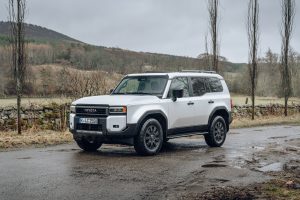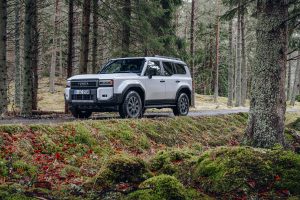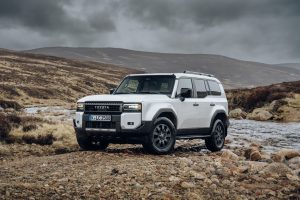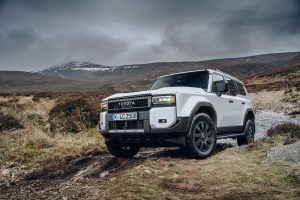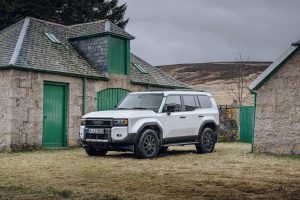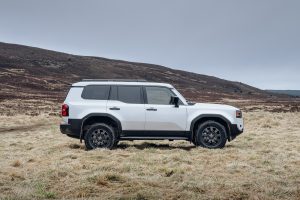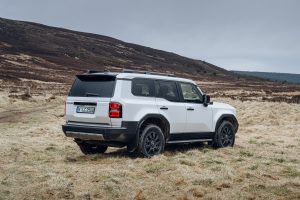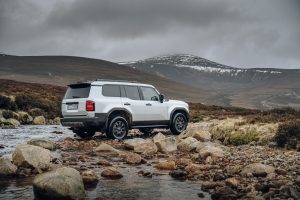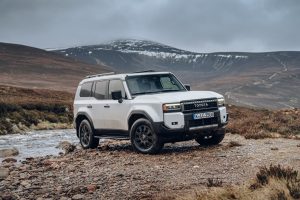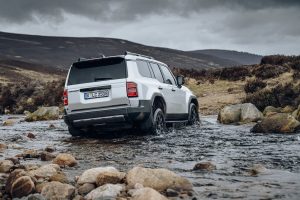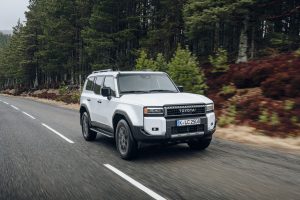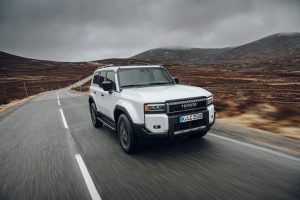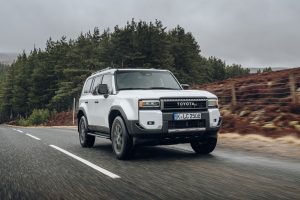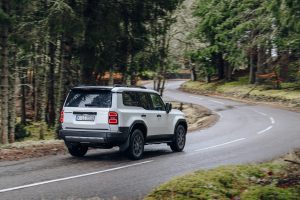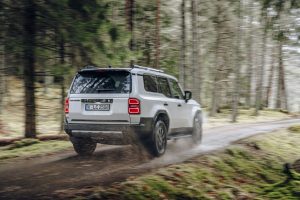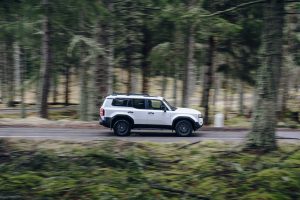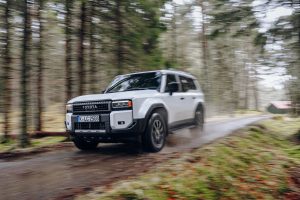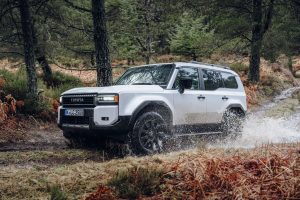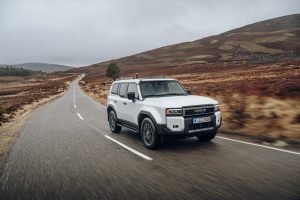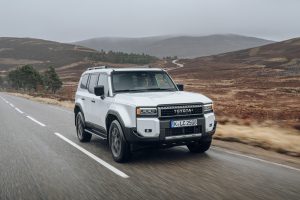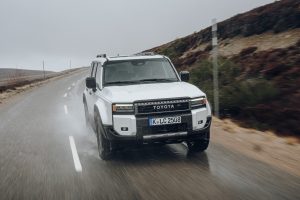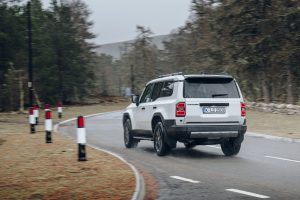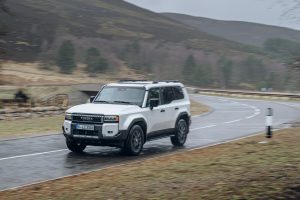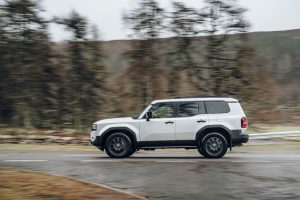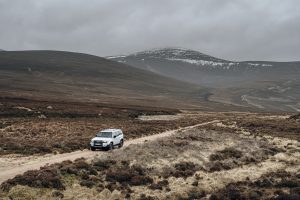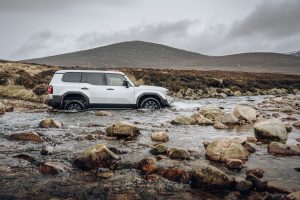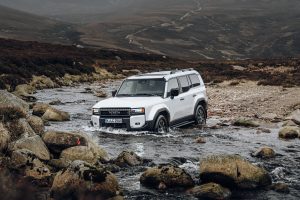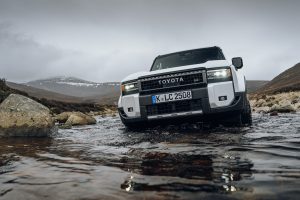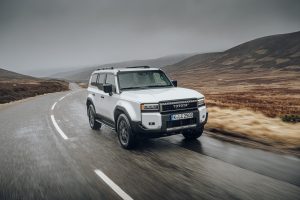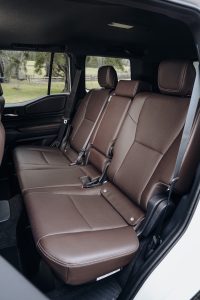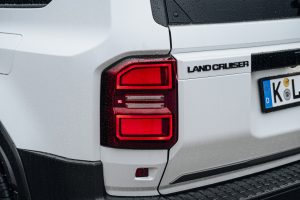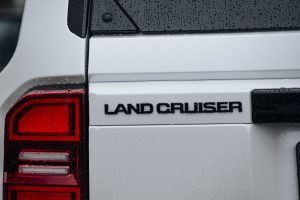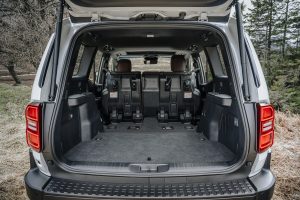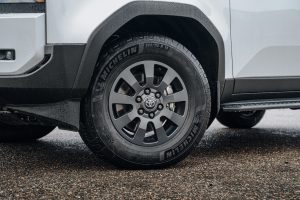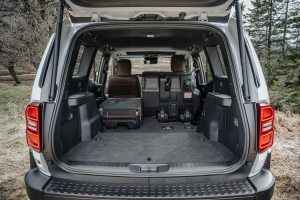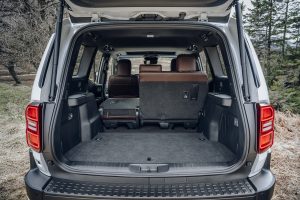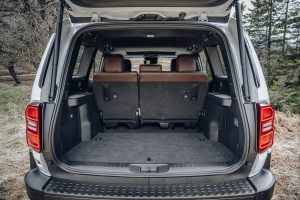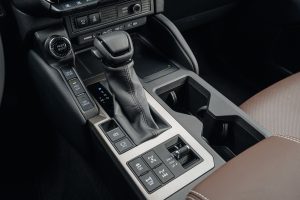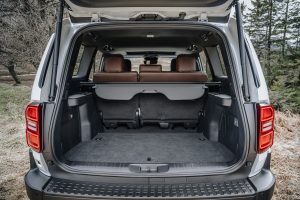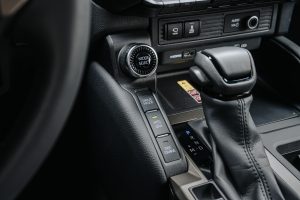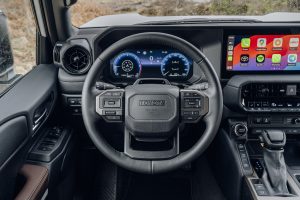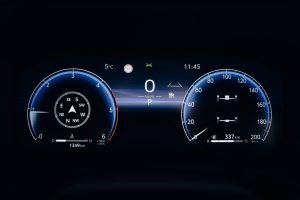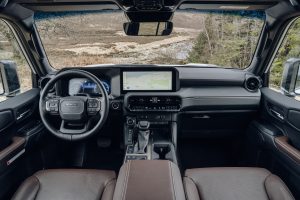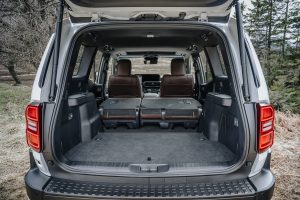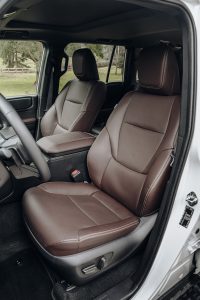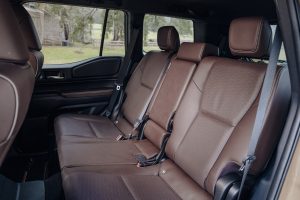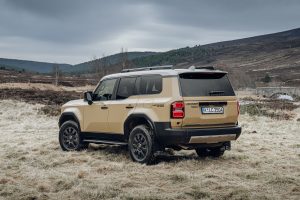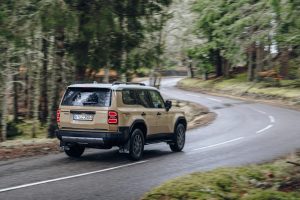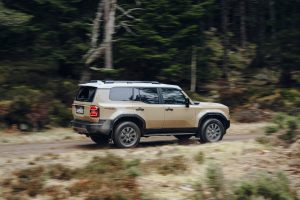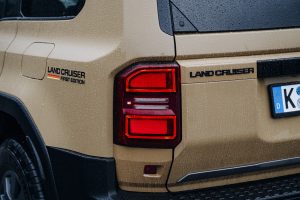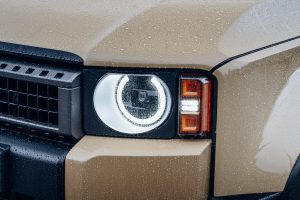The all-new Toyota Land Cruiser: a modern master true to its roots
- All-new Land Cruiser delivers the model’s traditional strengths of quality, durability and reliability
- Engineered to take the toughest conditions in its stride – the vehicle that will take you anywhere and everywhere, and bring you back, safe and sound
- Strong, purposeful design that draws on Land Cruiser’s heritage styling
- New body-on-frame Toyota New Global Architecture GA-F platform provides the foundation for significantly increased rigidity and excellent response, ride and handling – on and off-road
- First Land Cruiser to adopt electric power steering and a new disconnecting anti-roll bar system
- Re-engineered 2.8-litre turbodiesel engine with new eight-speed automatic transmission
- 48 V mild hybrid electric model to join the range in 2025
- UK model range and pricing to be announced shortly
The all-new Land Cruiser 250 is the latest generation of a model that across more than 70 years has built an unrivalled reputation for strength, reliability and the ability to cope with the harshest conditions, in all parts of the globe.
Today more than ever, the Land Cruiser is designed to be a vehicle you can rely on to take you anywhere and everywhere, and bring you back safe and sound.
The Land Cruiser family has evolved down the years into three parallel series:
- The Station Wagon: represented by today’s 300-series, which is available in world regions including Africa, the Middle East, Asia and the Pacific.
- The Heavy Duty: the world famous 70-series which is celebrating its 40th anniversary, available in African, Middle Eastern and Pacific markets.
- The Light Duty: the range that includes the all-new 250-series, the principal model for Europe.
The first Light Duty model (also known as the “Prado” in some regions) joined the global Land Cruiser range in 1985. Since that time, its evolution has seen it move closer in character to the more luxurious and larger Land Cruiser 300. Development of the 2024 250-series model has seen a conscious decision to bring the Land Cruiser back to its origins, focusing on its fundamental quality as a practical and affordable vehicle.
Chief Engineer Keita Moritsu explains: “We have changed our perception and believe that this Land Cruiser model should be offered as a practical and affordable off-roader. We resolved that going back to our roots would be core to the Land Cruiser brand going forward.”
The result is an all-new model that offers strong, authentic off-road performance, underpinned by its new GA-F platform and frame; excellent functionality for carrying passengers and cargo; enhanced visibility for the driver; and simplicity, with parts designed to be easy to repair or replace with customised items.
The “back to origins” quality is also evident in the vehicle design, which fuses Land Cruiser heritage with modernity. The robust styling projects reliability, a timeless look and the kind of functional solid quality associated with the best professional tools.
“This is not simply a homage,” says Chief Designer Yoshito Watanabe. “It interprets these elements in a modern design that evokes the essence of Land Cruiser.”
Details of the UK model range, specifications, pricing and sales will be announced shortly.
THE LAND CRUISER HERITAGE
The Land Cruiser was born 72 years ago as the “Toyota BJ”, on 1 August, 1951. Shortly afterwards it demonstrated its strength and capabilities by becoming the first vehicle to successfully climb to the sixth station on the slopes of Mount Fuji.
Ever since, Toyota’s mission for Land Cruiser has been to provide people with a vehicle that will take them to their destination in safety and security, even in the harshest environments. The different experiences of customers around the world have proved invaluable in evolving the Land Cruiser’s essential strengths of reliability, durability and the ability to tackle rough road conditions.
It’s perhaps no surprise that its enduring worldwide reputation has made it one of Toyota’s best-selling models, with 11.3 million sales to date*, across more than 170 countries and regions.
*As of June 2023, cumulative and annual sales volumes include the Lexus LX and Lexus GX models.
DESIGN: TRADITION BLENDED WITH MODERNITY
- Design expresses authentic off-roader performance in a fusion of heritage and modernity
- Silhouette and vehicle proportions reference Land Cruiser’s design heritage
- Measures adopted to secure excellent view for the driver, including a bonnet with raised corners and lowered central section
- Powerful frontal design with classic TOYOTA emblem
- Body shaped to help avoid damage in harsh conditions; parts designed to be easily replaced
- Interior presents a functional yet high-quality design with customisable digital instrument display and latest Toyota multimedia package
- Seating for up to seven on board, with generous load space provision
Exterior
The design of the new Land Cruiser is a clear expression of the vehicle’s status as a fully fledged off-roader that’s inherently strong and stable.
Its essential reliability is reflected in the shape and composition of parts designed to cope with harsh conditions and be easy to replace if damage occurs. There’s a timelessness, too, in design simplicity that expresses quality and will not look out-of-date, and a sense of professionalism in the form-follows-function design of the kind found in top-quality professional tools.
Brought together, these elements create a fusion of heritage and modernity: this is a Land Cruiser that is rooted in its origins, yet meets the highest contemporary standards.
The classic Land Cruiser silhouettereferences the definitive lines of the early Land Cruiser models (the 40 and 70-series Land Cruiser are clear influences) with a strong horizontal axis, a long bonnet, upright windscreen, a short front overhang and distinctive trapezoidal wheel arches. The proportions are also true to Land Cruiser’s design heritage, with a tight, box-shaped cabin set behind the car’s vertical axis to gain both interior space and comfort. The car’s overall length is 4,925mm, width 1,980mm and height 1,935mm; the wheelbase is 2,850mm.
The configuration and proportions of the frontal elements create a classic Land Cruiser look. Functional parts are grouped together towards the centre with high-set headlights to help avoid damage in tough driving conditions. The sense of purpose is further emphasised by the restoration of the classic TOYOTA logo front centre and at the rear above the licence plate garnish. Practicality is designed-in with bumper corners that are easy to replace if damaged.
The standard headlight options are a slim oblong triple-eye arrangement of LEDs or a classic round-eye projector bi-LED alongside vertically arranged turn indicator and daytime running lights. Again, with a view to avoiding damage, the front fog lights are deeply recessed in the bumper corners; the front and rear corners are chamfered (which also aids manoeuvrability); and the lower door sections have a scraped, concave surface.
Giving the driver the best view ahead and to the side was a design priority. This produced a bonnet shape with raised sides which make it easier to locate the vehicle’s corners, and a lowered centre section that improves the forward view, reducing the blind spot immediately in front of the vehicle. To improve the view to the side, the A pillar is set at a more upright angle, the mirrors are attached to the doors and the belt line has been stepped down – a reference to the classic Toyota BJ70 – by about 30mm compared to the current model.
The bodywork displays contrasting sharp hard and glossy curved surfaces for a simple, modern look with a sense of tension and high precision. The overall effect is of the Land Cruiser having been carved from a single lump of pure metal. The car’s wide stance, flared front and rear wings and the tight body shape combine to emphasise stable performance.
At the rear, the lights are again tightly grouped in vertically stacked combi-units.
According to model grade, the new Land Cruiser will feature 18 or 20-inch alloy wheels with new designs. The numerous colour options will include heritage Smoky Blue and Sand shades combined with a light grey roof. A wide range of body accessories will give customers the chance to tailor their vehicle to suit their requirements, including roof rails, side steps and an opening rear hatch.
Aerodynamic detailing
The distinctive exterior design incorporates a series of details to enhance the vehicle’s aerodynamic performance.
Features to help reduce air resistance include a shutter in the upper grille which closes at high speeds to inhibit the flow of air into the engine compartment, reducing air resistance and lift force. Spats are fitted ahead of the front wheels, reducing the airflow striking the tyres and directing air to help cool the brake discs. The spats are deformable, so can withstand rough road driving.
Other measures include a reduction in the difference between the levels of the front pillars and the rain gutters and precise calculation of the door mirror sweep-back angle and housing profile to suppress turbulence. Side door mouldings have been added to rectify airflow along the side of the vehicle and a rear spoiler helps manage airflow away from the back of the vehicle and reduce lift force.
Interior design
The interior design expresses a safe, functional look suitable for off-road driving with an emphasis on durability, high quality and measures to reduce fatigue.
The instrument panel and upper door mouldings have strong horizontal lines that make it easy to grasp the vehicle’s orientation in challenging conditions and make for an open cabin environment with excellent outward view for everyone on board. The panel’s cross-section is lowered in front of the front passenger, enhancing the open feel.
Information sources – the driver’s instrument combimeter and multimedia display are set high for easy visibility and there is a wide console area – a Land Cruiser characteristic – that keeps driving controls close at hand for quick and intuitive operation. The digital instrument display (nine or 12.3-inch according to equipment grade) presents meters and data with sharp graphics that are clear to read in all lighting conditions. The multimedia system is accessed via high-definition touchscreen (eight or 12.3-inch). The package includes cloud-based navigation that benefits from up-to-the-moment traffic information and the “Hey Toyota” assistant for voice command control of multiple functions and systems.
The physical shape of the switches and their operating methods have been unified – simple toggle or push controls – so the driver can operate them easily without having to look away from the wheel or change their posture. Professional rally drivers were consulted on the design of the combination of dial selector and push switch used for vehicle system functions such as the Multi-Terrain Select.
Knee pads and padded door shoulders provide protection when the going gets tough and the top of the door panel has a scooped profile so the driver has space for free elbow movement. The new steering wheel design reflects the solid, stable exterior styling, with wide spoke openings to help prevent fingers being injured in the event of steering kickback. The centre pad displays the classic TOYOTA logo, with function switches rationally organised on the left and right sections of the centre spokes.
A sense of precision and quality is expressed in the co-ordinated design of control switches and details such as the serrated patterns around the air vents and mode selector, the matching of thick upholstery materials with rope-like piping and trim parts that have the look of machined metal.
Throughout, there is a unified look to the interior, with consistent material quality, feel and appearance, communicating a strong character. Functional areas are flat and hard; touch points are soft and thickly covered with a sense of volume. Digital design techniques were used to combine different parts into a single unit, for example incorporating the combimeter and centre display within the large instrument panel so there is less segmentation.
A new, simplified headlining shape increases the sense of space, with options for an opening sunroof or a large, fixed panoramic roof that extends above the second-row seats.
Seating and upholsteries
The new Land Cruiser range offers both five and seven-seat interiors. The front seats have a new design to provide strong support when driving off-road and are available with power adjustment. The eight-way power-adjustable driver’s seat is available with a (manually) extending cushion that provides an extra 50mm of thigh support. Its design avoids opening a groove between the extension and the main cushion for seamless support.
The new front seats have thinner seatbacks, improving leg and knee room for rear seat passengers, and are available with integrated heating and ventilation. Thicker urethane cushions disperse pressure over a wider area of the occupant’s body and are shaped to promote the optimum pelvis angle, reducing the load on the waist and muscles. The cushion sits on a hard lower layer, a construction that helps prevent the occupant’s posture collapsing when turning or changing lanes. The side bolsters project further, helping keep the body in place when horizontal forces are experienced, as when driving over rough surfaces.
The second row seats are offered in a bench arrangement that divides 60:40, and on the seven-seat model the third row comprises two seats that can be folded flat manually or with power control.
The upholstery choices include genuine and synthetic leathers and the first use of SUMITEX, a new, hard-wearing fabric made with a strong yarn produced from recycled PET plastic from Toyota facilities in Japan.
Load space
In the new five-seat Land Cruiser the flat-floor load space is longer and wider than in the current model; in the seven-seat version the width is greater, but the length is unchanged when the third row seats are in use.
In the seven-seater there is space behind the third row seats for two 55cm suitcases. With the third row folded, there is room enough for three 86 cm cases plus one 81cm and one 69cm. In the five-seat model the space is slightly larger, accommodating a 75cm case in place of the 69cm bag.
The new Land Cruiser also has a top-hanged rear door as standard, improving the ease of access; power back door operation and an independently opening glass hatch are aso available.
POWERTRAIN RESPONSE, CONTROL AND EFFICIENCY
- 2.8-litre turbodiesel engine with 201bhp/204 DIN hp/150kW, re-engineered for driveability and efficiency
- New eight-speed automatic transmission
- 48V mild hybrid electric model to join the Land Cruiser 250 range during 2025
- Permanent all-wheel drive
Advances in engine response and driveability
In Western Europe, the new Land Cruiser is being introduced with a 2.8-litre turbodiesel engine re-engineered for improved driveability and a stronger balance of fuel efficiency and performance.
The 2,755cc in-line four-cylinder DOHC direct injection multivalve unit produces a maximum 201bhp/204 DIN hp/150kW at 3,000rpm and is matched to a new eight-speed Direct Shift automatic transmission. With maximum torque of 500Nm generated between 1,600 and 2,800rpm, it has the muscle to tow loads of up to 3,500kg.
Development of the new unit made acceleration control a priority, with performance that is faithful to the driver’s intentions, whether on road or off, driving city streets or on the open highway. The intention was that driving feel should be direct, like that experienced with a manual transmission. To help focus their work, the engineering team gathered knowledge from development of the Land Cruiser 300 and quality, durability and reliability intelligence from the current Land Cruiser Prado. Customer feedback about how the vehicle is used day-to-day was also analysed.
This helped produce advances in acceleration performance and driveability; improvements in noise and vibration levels; and enhanced handling in severe conditions. The powertrain is engineered to provide linear acceleration with a strong initial response, while the lock-up function in the eight-speed automatic transmission suppresses surges in engine revs.
A redesigned and more efficient turbocharger is key to the enhanced torque response, with the introduction of impeller with compact blades and a reduction in the unit’s diameter, A new belt layout makes space for the new electric power steering system (see below) and the adoption of a higher output (200A) alternator to ably support customer auxiliary power requirements.
Measures to address environmental performance include an increase in the efficiency of the SCR catalyst and an enlarged, 17-litre urea tank.
New eight-speed automatic transmission
The powertrain features a new eight-speed automatic transmission designed to enhance driving performance and fuel economy and offering quiet performance. With closer gear ratios, a new, compact torque converter and optimised components, the transmission delivers precise lock-up control, rhythmic shifting and a smooth acceleration feel.
The torque converter features a multi-plate lock-up clutch with an expanded range, contributing to the direct drive feel and overall fuel economy. Lock-up control can be implemented from low speeds, adding to the quality of the drive feel.
The unit also benefits from a new dynamic damper structure to help reduce torque fluctuations to the drive shaft. Both the torque converter and damper structure have been revised to reduce size and save weight.
The compact and lightweight geartrain provides both efficiency and durability. Close gear ratios are used at higher vehicle speeds with consistent, small changes in engine rpm when shifting in the high range to produce a rhythmic feel. The first gear ratio has been lowered to improve start-off acceleration and off-road performance, while eighth gear has an increased ratio for quieter high-speed cruising at lower engine revs, with enhanced fuel economy.
Shifting response is enhanced by 25% with the adoption of a new linear solenoid that is 29 per cent lighter than the previous unit, compared to the current six-speed automatic. Quieter performance and fuel economy are supported by a smaller-diameter oil pump.
Future 48V mild hybrid electric system
Toyota will introduce a mild hybrid electric version of the Land Cruiser in Europe in 2025, combining the 2.8-litre diesel engine with a 48V electric motor-generator, a compact 48V lithium-ion battery and a stop-start system. This will enhance the drivability, giving a smoother and quieter, yet more responsive performance while maintaining its ability to withstand tough driving conditions.
Permanent all-wheel drive
The driveline for the Land Cruiser’s permanent all-wheel drive features a revised propeller shaft structure designed for durability and quieter performance. Changes have also been made to the Torsen differentials: the centre unit has been revised for enhanced performance and fuel efficiency; the optional rear diff has been strengthened for added reliability. Both are turned to achieve the best balance of off-road traction and on-road stability.
The differential locking system has been changed from a motor to a solenoid type, giving 85 per cent quicker response (around 0.15 seconds) should the vehicle become stranded.
The transfer unit has also been updated for improved durability, an increase in actuator motor torque and anti-corrosion performance. A new toggle switch for selecting the H4 or L4 ranges and new diff lock switches are located on the centre console, next to the shift lever.
ON AND OFF-ROAD STABILITY, CONTROL AND CONFIDENCE
- Handling capabilities designed-in to ensure highest levels of off-road performance
- Composed, comfortable and easy to manoeuvre on-road
- New GA-F body-on-frame provides essential strength and rigidity
- First Land Cruiser to adopt electric power steering
- World-first Stabiliser Disconnect Mechanism to unlock front anti-roll bar and gain increased wheel articulation
- Multi-Terrain Select and Multi-Terrain Monitor help the driver negotiate challenging conditions
The essential quality of the Land Cruiser as a vehicle that can “take you anywhere and everywhere and bring you back safe and sound” includes the ability to tackle challenging off-road conditions. In taking the model back to its origins, Toyota has ensured that the vehicle has the fundamental, built-in strength to deliver on this promise, rather than relying on sophisticated technologies.
At the same time, easy manoeuvrability was a key consideration: beyond its off-road strengths, this is a vehicle that is simple in concept and composed and comfortable to drive for everyone in everyday use. Visibility is good, switchgear is simple to understand and intuitive to use and vehicle responses are prompt and faithful to the driver’s intentions.
Extreme testing
The development programme tested the new model to the limits of its endurance. Toyota constructed a new off-road test track – the daunting Course F at the Shibetsu proving ground in Japan – faithfully reproducing a range of the most challenging driving conditions from around the world.
The course’s design includes slopes, muddy tracks, rocky roads and mogul landscapes, each placing different demands on the vehicle. Using this facility not only helped confirm and enhance the new Land Cruiser’s off-road performance, “one step above” the current model, it also helped refine its suitability for everyday use and its functionality. Extensive testing has also taken place in the Middle East and Australia.
Capability founded on new GA-F platform and frame
Land Cruiser’s authentic off-road character is reflected in its retention of a body-on-frame construction, but its capability moves a step above the current model. The foundation for its performance is the new GA-F platform and frame, as also featured in the new Land Cruiser 300.
This gives the vehicle structure significantly greater strength and rigidity, achieved through a combination of focused construction techniques. The new model has 84 extra short-pitch weld points around the side doors and lower rocker edges and, for the first time, uses structural adhesive (a total of 11.9m) to enhance rigidity where sheet metal parts meet. Tailor-welded blanks have been introduced in the side rails and crossmember in place of reinforcements, maintaining rigidity while saving weight. Thick sheet steel and high-tensile materials are used in strategic locations throughout the frame to ensure robust strength.
Overall the torsional rigidity of the frame has increased by 50 per cent, while that of the frame and body combined has risen by 30 per cent. The result is a vehicle that responds and moves just as the driver intends.
First Land Cruiser with electric power steering
This is the first Land Cruiser model to be fitted with an electric power steering system (EPS).
Compared to a hydraulic system, EPS reduces the amount of kickback that can occur when driving over rough surfaces and provides smoother, more direct steering and easier manoeuvrability at all speeds. Using EPS also allows the new Land Cruiser to feature Lane Tracing Assist as part of its Toyota Safety Sense active safety and driver assistance package.
The rack-and-pinion system also saves energy, with electric power used only when required – ie not when idling or in straight-line driving.
To help communicate good feedback to the driver, steering column rigidity has been enhanced and the steering shaft and tube have been enlarged.
New braking system
The new electronically controlled braking system has been designed for improved feel and performance that matches the driver’s intentions. Control, performance and rigidity have been optimised to produce a natural and linear braking feel.
An on-demand pressure system provided by a general purpose VSC unit operates in addition to a conventional pressure system, enhancing the braking feel. Co-operative braking control combines the hydraulic braking force with regenerative braking force from the motor; maximising the use of regenerative braking force contributes to fuel economy.
Disc brakes are used: 340mm diameter at the front; 335mm at the rear. An electronic parking brake operates on the rear wheels.
Downhill Assist Control (DAC) can be used to automatically provide stable braking without wheel-lock while maintaining a low vehicle speed when negotiating steep descents. The system has been developed so that it can be used as a cruise control function at speeds between 2.5 and 18.5mph in the vehicle’s H4 and L4 range.
Crawl Control
Crawl Control can be used to maintain a low speed in off-road/downhill driving. It governs engine torque and brake pressure, avoiding wheelspin and wheel-locking and allowing the driver to focus on the steering.
Crawl Control operates in the L4 transfer mode. The driver can select the appropriate speed using the dial selector on the console. There are five different speed settings appropriate for a wide range of different driving surfaces and inclines.
Suspension
The front suspension features a new independent double wishbone system with extended stroke to gain high road-holding performance and off-road capability. It’s constructed from high-strength, lightweight components for durable, reliable performance.
A stable drive is supported by an increased caster trail while stability under braking is enhanced by a reduction in the kingpin offset angle and increase in the anti-dive angle.
At the rear the four-link rigid axle benefits from detailed revisions to achieve smoother, more linear performance while saving weight and enhancing reliability. The anti-roll bar is made from a new material that is both lighter and more rigid, while further weight is saved with a thinner axle cross-section and optimised bracket wall thickness – a design that also strengthens reliability. An increase in the anti-lift angle helps prevent rear-wheel lift. The entire geometry has been optimised so that the movement of each link is smooth and linear, helping secure a comfortable ride.
Stabiliser Disconnect Mechanism
The new Land Cruiser is the first Toyota to use a Stabiliser Disconnect Mechanism (SDM), which has the dual benefits of enhancing off-road performance and a more comfortable ride on standard roads.
Using a switch on the centre console, the driver can unlock the front anti-roll bar (stabiliser), increasing suspension travel. Travelling at low speeds on rough, rocky surfaces the extended wheel articulation helps keep all four wheels in contact with the ground, making the vehicle easier to manoeuvre. In standard form, the new Land Cruiser has 10 per cent greater wheel articulation compared to the current model; when the SDM is engaged, this increases by a further 10 per cent.
With the suspension able to elongate and contract freely, roll rigidity is reduced and body movement in all directions is suppressed, making for a more comfortable ride for all passengers on very rough terrain. When vehicle speed increases, the anti-roll bar will automatically be re-locked.
Multi-Terrain Select
The Multi-Terrain Select (MTS) adjusts the vehicle’s steering, drive force and hydraulic brake control to meet the demands of different off-road driving scenarios. The system now provides an additional Auto mode so the driver doesn’t have to alter the setting as conditions change and it can also be used when the car is in the high transfer mode as well as low.
MTS is simple to engage, using the powertrain control switch and multi-function dial selector on the centre console. In the low transfer mode the options are Mud, Sand, Rock and Auto; in high mode the choice is Mud, Sand, Dirt, Deep Snow and Auto.
Panoramic View Monitor/Multi-Terrain Monitor
The Land Cruiser’s Panoramic View Monitor (PVM) provides a complete view of the area immediately around and, using a Multi-Terrain Monitor (MTM) function, beneath the vehicle to help with precise manoeuvring on challenging terrain. The driver can switch between four cameras to check blind spots; the camera feeds can also be combined to create a composite image. The Under Vehicle Terrain View shows the position of the rear wheels and the driving surface. New MTM options include back underfloor view with guidelines showing the vehicle and tyre positions. The images in the display screen can be expanded using touch controls to gain an even more detailed view.
The PVM can be used at speeds up to 7.5mph and, for the first time in a Land Cruiser, can be activated using voice command as well as a console switch. A rear camera washer is available to help maintain a clear image.
QUIETNESS, COMFORT AND SAFETY
- Extensive noise and vibration countermeasures through the vehicle
- Focus on comfort with pitch control, new engine mount design and cushion mounts between the body and frame
- Comprehensive safety and driver assistance features, including latest generation of Toyota Safety Sense
The new Land Cruiser may be engineered to take extreme conditions in its stride, but that does not mean on-board quietness and comfort have been sacrificed. Extensive measures have been taken to avoid and counteract noise and vibration.
Vehicle development minimised the number of points where sound can enter the cabin and produced a body on frame design that is less prone to generating noise. Similarly, noise sources were identified and reduced.
Countermeasures include enhanced body sealing, for example at the base of the front and centre pillars, and gap sealing around the door apertures. Sound-absorbing material has been added to the air intake system and the wheel arch liners and even the tyre tread patterns have been calculated to reduce noise generation.
Compared to the current model, there is a thicker dash silencer with an intermediate layer, covering a larger area. Damping material has also been added to the vehicle floor. The higher rigidity of the new GA-F body and frame is also effective in dispersing the resonance of each part, damping vibration. An Active Noise Control system has been adopted which makes for a quieter environment when the car is idling or accelerating, with noise-cancelling soundwaves being transmitted through a cabin speaker.
Further measures contribute to securing a comfortable ride, including the increase in rigidity in the new GA-F platform and frame. Further gains have been made with the use of a pitch control system to maintain a smooth ride; a new engine mount design; cushion mounts between the body and frame; and direct connection of the seat frames to the vehicle body, rather than to an intermediate bracket.
Comprehensive safety features
The new Land Cruiser 250’s robust construction provides essentially strong protection in the event of an impact. But beyond its basic strength, it benefits from comprehensive provisions to help prevent accidents from happening and providing protection for everyone on board should an impact be unavoidable.
The package includes the latest generation of Toyota Safety Sense, with enhanced hardware that increases the scope of accident risk detection. Elements new to Land Cruiser include extension of the Pre-Collision System to include Intersection Collision Avoidance Support; Acceleration Suppression, which reacts to sudden use of the throttle in low-speed driving; and Emergency Steering Assist. Proactive Driving Assist gives further support at low speeds, detecting hazards such as parked vehicles and pedestrians in the roadway and supporting smooth steering and deceleration when approaching a preceding vehicle or driving through a bend.
Other new features include an Emergency Driving Stop System. When Lane Tracing Assist is engaged, this detects when the driver has stopped making steering, braking and throttle inputs over a period of time and issues an alert. If there is still no response, it brings the vehicle to a smooth stop and activates the hazard lights. Safe Exit Assist warns if there is a risk of a door being opened into the path of a vehicle or cycle approaching from the rear.
The Toyota Safety Sense systems can be kept up-to-date with software upgrades delivered over-the-air, avoiding the need for the vehicle to be taken to a service centre.
TECHNICAL SPECIFICATIONS
Data remain provisional pending homologation
| ENGINE | ||
| Engine type | Four cylinders in-line | |
| Displacement (cc) | 2,755 | |
| Valvetrain | 16-valve DOHC | |
| Fuel injection type | Common rail | |
| Bore x stroke (mm) | 92.0 x 103.6 | |
| Max power (bhp/DIN hp/kW @ rpm) | 201/204/150 @ 3,000 – 3,400 | |
| Max torque (Nm/rpm) | 500 @ 1,600 – 2,800 | |
| TRANSMISSION | ||
| Type | 8AT | |
| Ratios | 1st | 4.413 |
| 2nd | 2.808 | |
| 3rd | 1.950 | |
| 4th | 1.511 | |
| 5th | 1.274 | |
| 6th | 0.100 | |
| 7th | 0.793 | |
| 8th | 0.651 | |
| Reverse | 3.645 | |
| Final drive ratio | 3.583 | |
| PERFORMANCE | ||
| Acceleration 0-62mph (sec) | Pending homologation | |
| Max. speed (mph) | 102 – 18in wheels 105 – 20in wheels | |
| FUEL CONSUMPTION (WLTP) | ||
| Combined cycle (mpg) | Pending homologation | |
| Fuel tank capacity (l) | 80 | |
| EMISSIONS (WLTP) | ||
| Emissions standard | EURO6E | |
| CO2 emissions (g/km) | Pending homologation | |
| SUSPENSION | ||
| Front | Double wishbone | |
| Rear | Four-link rigid with lateral control arm | |
| BRAKES | ||
| Front | Ventilated discs | |
| Rear | Ventilated discs | |
| STEERING | ||
| Type | Rack and pinion, electric power steering | |
| Turns lock-to-lock | 3.24 | |
| OFF-ROAD PERFORMANCE | ||
| Approach angle (deg) | 32 | |
| Departure angle (deg) | 17 | |
| Minimum running ground clearance (mm) | 215.3 | |
| DIMENSIONS | ||
| Overall length (mm) | 4,925 | |
| Overall width (mm) | 1,980 | |
| Overall height (mm) | 1,935 | |
| Wheelbase (mm) | 2,850 | |
| Front track (mm) | 1,664 | |
| Rear track (mm) | 1,668 | |
| Front overhang (mm) | 935 | |
| Rear overhang (mm) | 1,140 | |
| Turning radius – tyre (m) | 6.0 | |
| Turning radius – body (m) | 6.4 | |
| Load space capacity (m3 VDA) | 1,063 | |
| WEIGHTS | ||
| Kerb weight (kg) | 2,330 – 2,550 | |
| Gross vehicle weight (kg) | 3,150 | |
| Towing capacity – braked (kg) | 3,500 | |
ENDS

